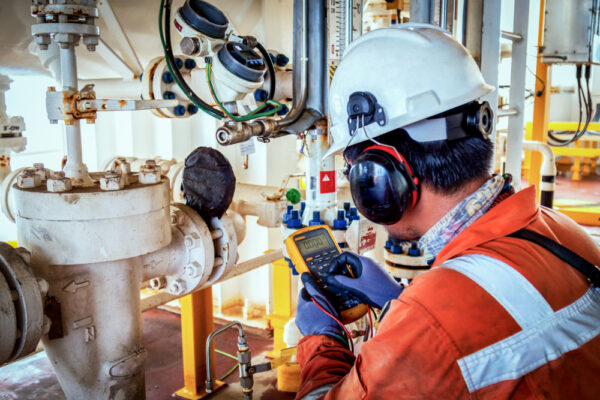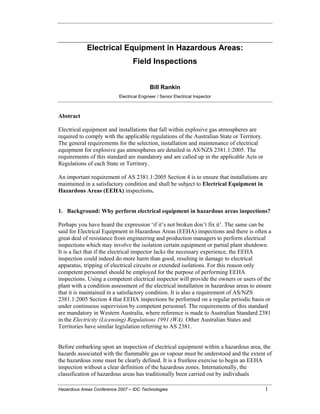The Ultimate Guide To Roar Solutions
The Ultimate Guide To Roar Solutions
Blog Article
The smart Trick of Roar Solutions That Nobody is Talking About
Table of Contents10 Easy Facts About Roar Solutions Shown5 Easy Facts About Roar Solutions DescribedGetting The Roar Solutions To Work
In order to shield setups from a possible explosion a technique of analysing and identifying a possibly unsafe location is required. The function of this is to ensure the appropriate selection and installment of equipment to ultimately avoid a surge and to make sure safety and security of life.
(https://padlet.com/thomascarrillo4740/roar-training-solutions-jrrziydpbb7m3xsa)
No devices ought to be set up where the surface area temperature level of the equipment is above the ignition temperature of the offered danger. Below are some common dirt harmful and their minimal ignition temperature. Coal Dirt 380C 225C Polythene 420C (melts) Methyl Cellulose 420C 320C Starch 460C 435C Flour 490C 340C Sugar 490C 460C Grain Dirt 510C 300C Phenolic Material 530C > 450C Aluminium 590C > 450C PVC 700C > 450C Soot 810C 570C The likelihood of the danger being existing in a concentration high adequate to trigger an ignition will certainly differ from place to area.
In order to identify this threat an installment is separated into locations of risk relying on the amount of time the harmful exists. These areas are described as Areas. For gases and vapours and dirts and fibres there are 3 zones. Zone 0 Area 20 A harmful ambience is extremely likely to be existing and may be existing for extended periods of time (> 1000 hours each year) or also continually Area 1 Zone 21 A hazardous ambience is possible but not likely to be existing for extended periods of time (> 10 450 C [842 F] A classification of T6 means the minimum ignition temperature level is > 85 C [185 F] Unsafe location electric devices maybe designed for use in higher ambient temperature levels. This would certainly suggested on the score plate e.g. EExe II C T3 Ta + 60C( This indicates at 60C ambient T3 will certainly not be exceeded) T1 T1, T2, T3, T4, T5, T6 T2 T2, T3, T4, T5, T6 T3 T3, T4, T5, T6 T4 T4, T5, T6 T5 T5, T6 T6 T6 A T Class rating of T1 suggests the optimum surface area temperature produced by the instrument at 40 C is 450 C. Thinking the associated T Class and Temperature rating for the tools are suitable for the location, you can constantly use a tool with an extra strict Division score than needed for the location. There isn't a clear solution to this question unfortunately. It truly does depend upon the sort of devices and what fixings need to be performed. Equipment with particular test treatments that can not be performed in the field in order to achieve/maintain 3rd party rating. Need to return to the manufacturing facility if it is prior to the equipment's service. Field Fixing By Authorised Personnel: Complex screening may not be required however specific treatments may need to be adhered to in order for the equipment to maintain its third celebration ranking. Authorized personnel must be employed to do the job properly Repair service should be a like for like replacement. New element have to be thought about as a direct substitute needing no unique testing of the devices after the fixing is complete. Each tool with a harmful ranking must be reviewed independently. These are detailed at a high degree listed below, but for more comprehensive details, please refer straight to the guidelines.
The 8-Second Trick For Roar Solutions
The devices register is a thorough data source of devices documents that includes a minimum set of areas to determine each thing's place, technical parameters, Ex-spouse classification, age, and environmental data. This details is essential for tracking and managing the devices efficiently within unsafe areas. On the other hand, for routine or RBI tasting evaluations, the quality will be a combination of Detailed and Close inspections. The ratio of Detailed to Shut assessments will certainly be figured out by the Tools Threat, which is evaluated based on ignition risk (the likelihood of a resource of ignition versus the likelihood of a combustible environment )and the hazardous area classification
( Zone 0, 1, or 2). This variant will certainly additionally influence the resourcing needs for job prep work. Once Great deals are defined, you can develop sampling strategies based on the example dimension of each Lot, which describes the number of random tools items to be examined. To establish the called for example size, two elements require to be assessed: the dimension of the Great deal and the category try this of examination, which suggests the degree of initiative that must be used( reduced, normal, or increased )to the assessment of the Great deal. By combining the classification of examination with the Lot dimension, you can then establish the proper rejection requirements for a sample, implying the allowed variety of malfunctioning things located within that example. For even more details on this process, please refer to the Power Institute Standards. The IEC 60079 common suggests that the optimum period in between evaluations should not exceed three years. EEHA assessments will also be conducted beyond RBI campaigns as component of set up upkeep and tools overhauls or repair services. These examinations can be attributed towards the RBI example dimensions within the influenced Great deals. EEHA inspections are conducted to identify mistakes in electric equipment. A heavy racking up system is important, as a single piece of equipment may have numerous mistakes, each with varying levels of ignition risk. If the consolidated score of both evaluations is less than two times the fault rating, the Lot is regarded acceptable. If the Whole lot is still thought about undesirable, it has to undertake a full examination or justification, which may trigger more stringent evaluation protocols. Accepted Great deal: The reasons for any kind of mistakes are recognized. If a typical failing setting is discovered, added devices might require evaluation and repair service. Faults are classified by extent( Safety, Stability, House cleaning ), making certain that immediate problems are examined and resolved immediately to mitigate any kind of influence on safety and security or procedures. The EEHA data source should track and tape the lifecycle of faults together with the restorative actions taken. Executing a durable Risk-Based Inspection( RBI )strategy is crucial for guaranteeing conformity and safety in managing Electric Devices in Hazardous Locations( EEHA) (eeha certificate). Automated Fault Rating and Lifecycle Monitoring: Easily manage mistakes and track their lifecycle to boost evaluation precision. The introduction of this assistance for risk-based assessment better strengthens Inspectivity's setting as a best-in-class service for regulative conformity, in addition to for any asset-centric inspection usage situation. If you have an interest in discovering much more, we welcome you to request a presentation and find how our remedy can change your EEHA management processes.
The Single Strategy To Use For Roar Solutions

In terms of eruptive threat, a dangerous location is an atmosphere in which an explosive environment is present (or may be expected to be existing) in amounts that require special preventative measures for the building, installment and use tools. high voltage courses. In this short article we discover the difficulties encountered in the workplace, the danger control steps, and the needed expertises to work securely
It is a consequence of modern-day life that we produce, store or take care of a series of gases or liquids that are considered flammable, and a range of dusts that are considered flammable. These substances can, in specific problems, create explosive atmospheres and these can have major and awful consequences. A lot of us are familiar with the fire triangular remove any among the three components and the fire can not occur, however what does this mean in the context of unsafe areas? When breaking this down right into its easiest terms it is basically: a mix of a certain amount of release or leak of a specific substance or material, blending with ambient oxygen, and the existence of a source of ignition.
In most circumstances, we can do little about the levels of oxygen airborne, however we can have substantial influence on sources of ignition, as an example electric devices. Unsafe locations are recorded on the hazardous area classification drawing and are identified on-site by the triangular "EX" indication. Below, among other essential details, areas are divided into three kinds relying on the risk, the chance and period that an eruptive atmosphere will certainly exist; Area 0 or 20 is considered one of the most unsafe and Zone 2 or 22 is considered the least.
Report this page